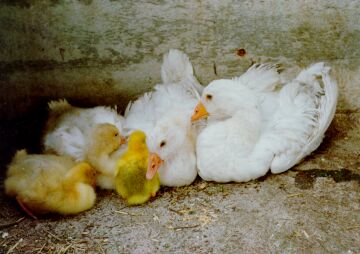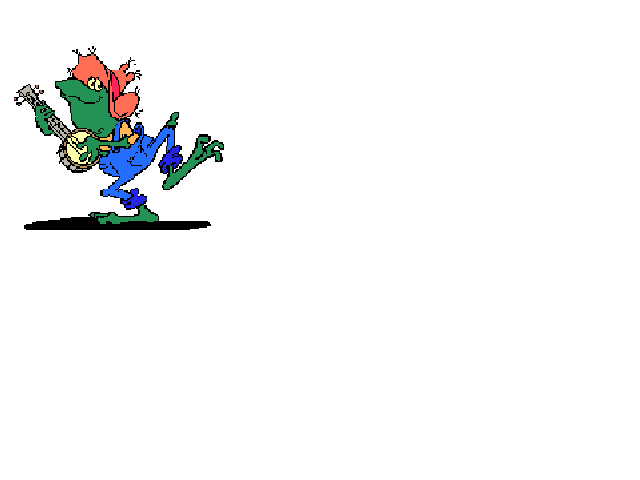| Hungarians are also working to improve the
quality of their geese. They are bred in special
farms such as the Godollo Agricultural
University, the Babat farm - which specializes in
a very good liver hybrid - or Babolna, Kecskemet,
Radszalmasi, Szentmiklos farms. One of the most
successful is Kolos-Agro Kft - a Danish and
Hungarian joint venture with 22 farms all over
Hungary. Around 120-150,000 pairs of Kolos geese
parents are in the Hungarian circuit coming from
company's research farm at Ocsa of 10,000 geese. The manager of this farm, Zsolt
Varga, explains their success: "In our farm
the geese's body tissue and quality is checked by
computerized tomographs." Kaposvary Panon
Agricultural University with the help of Siemens
, sponsors the research carried out by their
computer tomograph center. "This method
gives very precise data that help us produce good
quality geese. The white and grey Kolos is now
the most popular breed of geese in Hungary; 30%
of Hungarian geese come from this farm. We sell
abroad too, which is pretty good considering we
started the farm only five years ago."
According to Laszlo Peter, the
director of Kolos-Agro, their program is unique
in the whole world and represents a great genetic
step forward. "Domestic production should put the
emphasis on quality and not on the quantity of
goose liver. A good quality liver - without any
fat tissue - depends on the breed and on the
feeding techniques which are not so up-to-date
here," Peter said. "If we succeed in
improving it we'll make use of the market
possibilities, not ruin them."
There are 12 Hungarian big processing units
that fulfill all the requirements to export. Some
of them are in Kecskemet, Bekescsaba,
Kiskunhalas (established in 1852), Mezokovacshaza, Oroshaza and Hajdu
county. Some are in foreign investors hands such
as Sarvari - an English investor, or the German-owned unit in Oroshaza one.
The one-day-geese are bought by the processing
units from the breed farms and they are resold
for rearing to private families. Each of the
more than 500 families working with Kiskunhalas
processing plant rears 1,000-15,000 geese a
year.
When their liver is at least 400 grams, the
farmers sell them back to the processing plant.
Health control is made by a state
employee who makes sure the regulations of the
European Union are respected.
Then trucks full of goose liver packed between
layers of broken ice go abroad to canning
plants, restaurants and shops. The French state
controls by polls that requirements of quality
and hygiene are respected.
"Since 1992 Hungary is an associated
member of the European Community," says
Kallay, "it is time that we should have an
unique market policy. The European countries
apply the same rules to imports from the third
world. Until we get full membership of the Union
we have a lot to fight with. We produce the whole
range of agricultural products. No wonder,"
he said, "France or Spain or Holland- which
agriculture is as strong as ours - is not happy
about Hungary's joining in.
"We expect a clash of interests. When we
will be a member country, we will count very
seriously on the market. Until now we've
experienced a lot of animosity coming from the
Union. They try to raise all kinds of obstacles
to Hungarian export." From 1995 the duties
will be raised at some items even twice- such as
goose breast- according to GATT regulations.
Then they ask health certificates, viruses
tests for each animal, that can't be produced.
"I can't believe they themselves comply with
those regulations. So Hungary complained."
Richard Protzel, the president for the German
branch of EUWEP (European Union Wild Game and
Poultry) confirms that Hungarian complaints are
legitimate. "As a customer" - he
imports Hungarian goose meat - "my interest
is that Hungarian products can be imported with
reduced duties. I succeeded in making it easier
for Hungarians to export. There are too many,
unnecessary documents and special licenses
needed. A lot of import control made by
veterinarians is going on."
According to Kallay, Hungarian processed goose
liver is not successful on the world's market for
everybody is looking for "Made in
France" liver. "We need to market more
agressively to sell and prove that ours is as
good as the French one. They would like us to
produce only raw liver- which they sell at
double the price after processing it."
The plans to cut exports of raw liver made
some consider processing it in Hungary. Jasdi
states: "We sell goose liver fresh or
frozen. For the foreign buyers the ultimate goose
liver is a French product like champagne or
cognac. But we have plans to develop our industry
and make a name for ourselves abroad."
|

